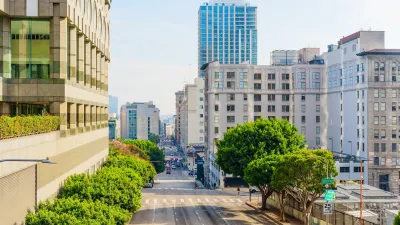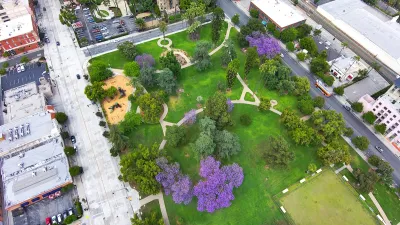In the latest entry in its fascinating series on the "Laws That Shaped L.A.", KCET's Jeremy Rosenberg looks at the city's brief, but golden, age of the Jitneys, and whether they deserve a return to L.A.'s growing mix of transit modes.
Rosenberg targets Chapter 213 from the Laws of 1917, nominated by James Rojas, city planner and founder of Place It! workshops and the Latino Urban Forum, one of "a series of escalating public policy and enforcement obstacles enacted
during that era that crashed the jitneys' fast-growing business model
while preserving the mass public transportation status quo."
So what's so important about Jitneys? According to Rosenberg, in their golden age, "L.A.'s jitneys often traveled alongside established and maintained
streetcar lines. Jitneys charged a bargain five cents per ride. Jitneys
were more responsive to the micro-needs of passengers. Jitneys required
very little capital expense to operate."
Jitneys can play an important role in reaching under-served communities today, at a reasonable price, and can fill the gaps in L.A.'s growing transit system. "[A jitney is] market and demand driven, flexible, and requires very
little subsides," Rojas says. "It reaches any location in L.A. County
where there is a road, any time of day."
"Rojas is not in favor of privatizing everyone's commute...Instead, Rojas pushes for equanimity. 'I think we have to let the
free market help solve public transportation,' he says. 'Its like the
NYC MTA runs the buses and subways and private companies run the taxis.
It's a balanced set-up.'"
FULL STORY: Free the Jitney! When Buses, Rail, Bikes and Feet Ain't Enough

Alabama: Trump Terminates Settlements for Black Communities Harmed By Raw Sewage
Trump deemed the landmark civil rights agreement “illegal DEI and environmental justice policy.”

Planetizen Federal Action Tracker
A weekly monitor of how Trump’s orders and actions are impacting planners and planning in America.

The 120 Year Old Tiny Home Villages That Sheltered San Francisco’s Earthquake Refugees
More than a century ago, San Francisco mobilized to house thousands of residents displaced by the 1906 earthquake. Could their strategy offer a model for the present?

LA’s Tree Emergency Goes Beyond Vandalism
After a vandal destroyed dozens of downtown LA trees, Mayor Karen Bass vowed to replace them. Days later, she slashed the city’s tree budget.

Sacramento Leads Nation With Bus-Mounted Bike Lane Enforcement Cameras
The city is the first to use its bus-mounted traffic enforcement system to cite drivers who park or drive in bike lanes.

Seattle Voters Approve Social Housing Referendum
Voters approved a corporate tax to fund the city’s housing authority despite an opposition campaign funded by Amazon and Microsoft.
Urban Design for Planners 1: Software Tools
This six-course series explores essential urban design concepts using open source software and equips planners with the tools they need to participate fully in the urban design process.
Planning for Universal Design
Learn the tools for implementing Universal Design in planning regulations.
Ada County Highway District
Clanton & Associates, Inc.
Jessamine County Fiscal Court
Institute for Housing and Urban Development Studies (IHS)
City of Grandview
Harvard GSD Executive Education
Toledo-Lucas County Plan Commissions
Salt Lake City
NYU Wagner Graduate School of Public Service




























